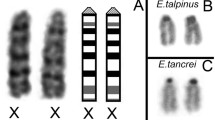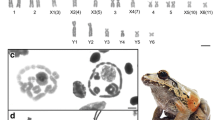Abstract
InLocusta migratoria (XO),Mus musculus, Rattus norvegicus, Mesocricetus auratus, Cricetulus griseus andHomo sapiens typical sex vesicle structures are visible in early meiotic prophase stages up to pachynema. The structures include whole sex chromosomes or parts thereof. The heterologous parts and the solitary X chromosome ofLocusta pass diplonema, diakinesis and first metaphase nearly in mitotic shape. Entirely heterologous sex chromosomes are kept together by a unilateral and achiasmatic end connection. The sex vesicle is interpreted as a special structure of allocyclic sex chromosomes or parts of them, corresponding in early meiotic stages to the chromocenters of mitotic interphase nuclei. The formation of the sex vesicle is independent of the orthoploidy of nuclei and of the DNA ratio between autosomes and sex chromosomes. Heteropycnotic behaviour of sex chromosomes in spermatids is interpreted as a condition capable of blocking genetic activity, like in the Barr bodies of female somatic nuclei, giving equal chances of fertilization to both types of gametes.
Similar content being viewed by others
References
Barr, M. L. &E. J. Bertram (1951). A morphological distinction between neurons of the male and female, and the behaviour of the nucleolar satellite during accelerated nucleoprotein synthesis.J. Anat. 85: 171.
Bassermann, F. J. (1957). Zahl und Größe der geschlechtsspezifischen Chromatindifferenzierung in polyploiden endomitotisch verdoppelten Kernen von Flimmerzellen des menschlichen Bronchialepithels.Ärztl. Wschr. 12: 307–309.
Beermann, W. (1962). Riesenchromosomen. Protoplasmatologia VI D. Springer-Verlag, Wien.
Blechschmidt, H. (1961). Die vorgeburtlichen Entwicklungsstadien des Menschen. Karger-Verlag, Basel.
Bodian, M., M. Fraccaro, G. H. Newns &A. I. Taylor (1962). A human intersex (“true hermaphrodite”) with XX/XXY/XXYYY sex chromosomes.Cytogenetics 1: 104–112.
Borum, K. (1961). Oogenesis in the mouse. A study of the meiotic prophase.Exper. Cell Res. 24: 495–507.
Boyden, A. A. (1953). Comparative evolution with special reference to primitive mechanisms.Evolution 7: 21–31.
Bürger, M. (1961). Über das Sex-Chromatin in diploiden und tetraploiden Parenchymkernen menschlicher Leberpunktate.Beitr. path. Anat. 125: 173–188.
Cleveland, L. R. (1947). The origin and evolution of meiosis.Science 105: 287–289.
Cooper, K. W. (1959). Cytogenetic analysis of major heterochromatic elements (especially Xh and Y) in Drosophila melanogaster and the theory of “heterochromatin”.Chromosoma (Berl.)10: 535–588.
Cooper, H. L. (1962). Recent advances in human chromosome studies bearing on sex determination.J. nat. med. Ass. (N.Y.)54: 415–430.
Crosby, J. L. (1955). The evolution of mitosis.Proc. Univ. Durham Philos. Soc. XII: 73–81.
Davidson, R. G., H. M. Nitowsky &B. Childs (1963). Demonstration of two populations of cells in the human female heterozygous for glucose-6-phosphate dehydrogenase variants.Proc. Natl. Acad. Sci. U.S.50: 481–485.
Eberle, P. (1963). Meiotische Chromosomen des Mannes.Klin. Wschr. (Heidelberg)41: 848–856.
Darlington, C. D. (1958). Evolution of genetic systems. Oliver and Boyd, London.
Emmons, L. R. &L. Husted (1962). The sex bivalent of the golden hamster.J. Heredity 53: 227–232.
Falconer, D. S. (1953). Total sex-linkage in the house mouse.Z. indukt. Abst. Vererbungsl. 85: 210–219.
Ford, C. E. &J. L. Hamerton (1956). The chromosomes of man.Nature (Lond.)178: 1020–1022.
Fraccaro, M., H. P. Klinger &W. Schutt (1962). A male with XXXXY sex chromosomes.Cytogenetics (Basel)1: 52–64.
Fraser, G. R. (1963). Parental origin of the sex chromosomes in the XO and XXY karyotypes in man.Ann. hum. Genet. 26: 297–304.
Geitler, L. (1937). Die Analyse des Kernbaus und der Kernteilung der WasserläuferGerris lateralis undGerris lacustris (Hemiptera heteroptera) und die Somadifferenzierung.Z. Zellforsch. 26: 641–672.
Geyer-Duszyńska, J. (1963). On the structure of the XY bivalent inMus musculus.Chromosoma (Berl.)13: 521–525.
Hay, J. C. &K. L. Moore (1961). The sex chromatin in various mammals.Acta anat. (Basel)45: 289–309.
Heitz, E. (1933). Die somatische Heteropyknose beiDrosophila melanogaster und ihre genetische Bedeutung. (Zytologische Untersuchungen an Dipteren III).Z. Zellforsch. 20: 237–287.
Hienz, H. A. (1959). Die zellkernmorphologische Geschlechtserkennung in Theorie und Praxis. Dr. Alfred Hüthig Verlag, Heidelberg.
Hinrichsen, K. (1957). Cytologische Geschlechtsbestimmung an somatischen Zellen von Kaninchen.Verhandl. Anat. Ges. Freiburg/Br. 287–294.
Hsu, T. C. (1948). The relations between heteropycnosis, spiralization and lampbrush formation of the chromosomes in the spermatogenesis of the Acrididae.J. Genet. 48: 311–315.
Hughes-Schrader, S. (1943). Meiosis without chiasmata in diploid and tetraploid spermatocytes of the mantidCallimantis antillarum Saussure.J. Morph. 73: 111–140.
Huizinga, J. (1963). Inactivation of the X-chromosome.Koninkl. Nederl. Akad. Wetenschappen Series C66: 119–121.
Husted, L., J. T. Hopkins &M. B. Moore (1945). The X-bivalent of the golden hamster (Cricetus auratus).J. Hered. 36: 93–96.
James, J. (1960). Observations on the so-called sex chromatin.Z. Zellforsch. 51: 597–616.
Kaufmann, B. P. (1957). A portrait of the chromosome.Bios 28: 21–35.
Klinger, H. P. &H. G. Schwarzacher (1960). The sex chromatin and heterochromatic bodies in human diploid and polyploid nuclei.J. Biophys. Biochem. Cytol. 8: 345–364.
Knapp, E. (1935). Zur Frage der genetischen Aktivität des Heterochromatins, nach Untersuchungen am X-Chromosom vonSphaerocarpus donnellii.Ber. dtsch. bot. Ges. 53: 751–760.
Koller, P. C. (1937). The genetical and mechanical properties of the sex chromosomes. III. Man.Proc. Roy. Soc. Edinb. B57: 194–214.
Koller, P. C. (1938). The genetical and mechanical properties of the sex chromosomes. IV. The golden hamster.J. Genet. 36: 177–195.
Koller, P. C. &C. D. Darlington (1934). The genetical and mechanical properties of the sex chromosomes. I.Rattus norvegicus male.J. Genet. 29: 159–173.
Lindstein, J., P. Bowen, C. S. N. Lee, V. A. McKusick, P. E. Polani, M. Wingate, J. H. Edwards, J. Hammer, P. Tippett, R. Sanger &R. R. Race (1963). Source of the X in XO females: The evidence of Xg.Lancet I: 558–559.
Lorbeer, G. (1934). Die Zytologie der Lebermoose mit besonderer Berücksichtigung allgemeiner Chromosomenfragen.Jahrb. wiss. Bot. 80: 567–817.
Lyon, M. F. (1962). Sex chromatin and gene action in the mammalian X-chromosome.Amer. J. hum. Genet. 14: 135–148.
Lyon, M. F. (1963). Attempts to test the inactive-X theory of dosage compensation in mammals.Genet. Res. 4: 93–103.
Matthey, R. (1951). The chromosomes of vertebrates.Adv. Genet. 1: 159–180.
Melander, Y. &E. Hansen-Melander (1962). Sex chromosome allocyly in the male rabbit.Hereditas 48: 662–666.
Meyer, G. F., O. Hess &W. Beermann (1961). Phasenspezifische Funktionsstrukturen in Spermatocytenkernen vonDrosophila melanogaster und ihre Abhängigkeit vom Y-Chromosom.Chromosoma (Berl.)12: 676–716.
Mittwoch, U. &J. D. A. Delhanty (1961). Nuclear sex in triploid XXY human cells.Lancet II: 552.
Mohr, O. L. (1916). Sind die Heterochromosomen wahre Chromosomen? Untersuchungen über ihr Verhalten in der Ovogenese vonLeptophyes punctatissima.Arch. Zellforsch. 14: 151–176.
Moore, K. L. (1962). The sex chromatin: Its discovery and variations in the animal kingkom.Acta Cytol. 6: 1–12.
Muldal, S. (1962). Origin of the Barr body.Lancet II: 1384–1385.
Muldal, S., C. W. Gilbert, L. G. Lajtha, J. Lindsten, J. Rowley &M. Fraccaro (1963). Tritiated Thymidine incorporation in an isochromosome for the long arm of the X-chromosome in man.Lancet I: 861–863.
Ohno, S. (1962). More about the mammalian X-chromosome.Lancet II: 152–153.
Ohno, S., W. Kaplan &R. Kinosita (1959). On the end-to-end association of the X- and Y-chromosomes ofMus musculus.Exper. Cell Res. 18: 282–290.
Ohno, S., W. Kaplan &R. Kinosita (1959). Formation of the sex chromatin by a single X-chromosome in liver cells ofRattus norvegicus.Exper. Cell Res. 18: 415–418.
Ohno, S., W. Kaplan &R. Kinosita (1960). On the isopycnotic behavior of the XX-bivalent in oocytes ofRattus norvegicus.Exper. Cell Res. 19: 637–639.
Ohno, S., W. Kaplan &R. Kinosita (1961). X-chromosome behavior in germ and somatic cells ofRattus norvegicus.Exper. Cell Res. 22: 535–544.
Ohno, S., S. Makino, W. D. Kaplan &R. Kinosita (1961). Female germ cells of man.Exper. Cell Res. 24: 106–110.
Ohno, S., H. P. Klinger &N. B. Atkin (1962). Human Oogenesis.Cytogenetics 1: 42–51.
Ohno, S &C. Weiler (1961). Sex chromosome behavior pattern in germ and somatic cells ofMesocricetus auratus.Chromosoma 12: 362–373.
Ohno, S. &C. Weiler (1962). Relationship between large Y-chromosome and side-by-side pairing of the XY-bivalent observed in the Chinese hamster,Cricetulus griseus.Chromosoma (Berl.)13: 106–110.
Overzier, C. (1961). Die Intersexualität. Georg Thieme Verlag, Stuttgart.
Painter, T. S. (1923). Studies in mammalian spermatogenesis. II. The spermatogenesis of man.J. Exper. Zool. 37: 291–321.
Park, W. W. (1957). The occurrence of sex chromatin in early human and macaque embryos.J. Anat. 91: 369–373.
Pontecorvo, G. (1943). Meiosis in the striped hamster (Cricetulus griseus Milne Edw.) and the problem of heterochromatin in mammalian sex chromosomes.Proc. Roy. Soc. B62: 32–42.
Reitberger, A. &E. Buchner (1958). Zur Karyologie der Meiose des LebermoosesSphaerocarpus donnellii.Chromosoma (Berl.)9: 258–268.
Rensch, B. (1954). Neuere Probleme der Abstammungslehre: Die transspezifische Evolution. 2. Aufl., Enke Verlag, Stuttgart.
Roosen-Runge, E. C. &L. O. Giesel (1950). Quantitative studies on spermatogenesis in the albino rat.Amer. J. Anat. 87: 1–30.
Roosen-Runge, E. C. &L. O. Giesel (1951). Quantitative studies on spermatogenesis in the albino rat. II. The duration of spermatogenesis and some effects of colchicine.Amer. J. Anat. 88: 163–176.
Sachs, L. (1954). Sex-linkage and the sex chromosomes in man.Ann. Eugen. 18: 255–261.
Sachs, L. (1955). The possibilities of crossing-over between the sex chromosomes of the house mouse.Genetics 27: 309–322.
Schrader, F. (1928). Die Geschlechtschromosomen. Gebrüder Borntraeger, Berlin.
Shiwago, P. J. &A. H. Andres (1932). Die Geschlechtschromosomen in der Spermatogenese des Menschen.Z. Zellforsch. 16: 413–431.
Slizynski, B. M. (1955). Chiasmata in the male mouse.J. Genet. 53: 591–596.
Tobias, P. N. (1956). Chromosomes, sex-cells and evolution in a mammal. Percy Lund Humpheries & Co., London.
Stern, C. (1957). The problem of complete Y-linkage in man.Amer. J. Hum. Genet. 9: 147–166.
Stern, C. (1960). Dosage compensation—development of a concept and new facts.Canad. J. Genet. Cytol. 2: 105–118.
Stewart, J. &A. R. Sanderson (1961). Sex-chromatin body in normal human testis.Lancet I: 79–81.
Stoeckel, W. (1943). Lehrbuch der Geburtshilfe. Gustav Fischer Verlag, Jena.
Ullerich, F. H. (1961). Achiasmatische Spermatogenese bei der SkorpionsfliegePanorpa (Mecoptera).Chromosoma (Berl.)12: 215–232.
Westergaard, M. (1958). The mechanism of sex determination in dioecious flowering plants.Adv. Genet. 9: 217–281.
White, M. J. D. (1933). Tetraploid spermatocytes in a locust,Schistocerca gregaria.Cytologia 5: 135–139.
White, M. J. D. (1951). Cytogenetics of orthopteroid insects.Adv. Genet. 4: 268–326.
White, M. J. D. (1954). Animal cytology and evolution. 2nd ed., Cambridge Univ. Press, New York.
White, M. J. D. (1960). Are there no mammal species with XO males, and if not, why not?Amer. Naturalist 94: 301–304.
Winge, O. (1932). The nature of sex chromosomes. Proc. 6th Int. Congr. Genet.1: 343–355.
Winiwarter, H. de (1912). Etudes sur la spermatogenese humaine. I. Cellule de Sertoli. II. Héterochromosome et mitoses de l'épithelium séminal.Arch. de Biol. 27: 91–189.
Witschi, E. (1959). Age of sex-determining mechanisms in vertebrates.Science 130: 372–375.
Yerganian, G. (1959). Chromosomes of the chinese hamster,Cricetulus griseus. I. The normal complement and identification of sex chromosom.Cytologia 24: 66–75.
Author information
Authors and Affiliations
Additional information
Based on a paper read at the XI International Congress of Genetics, of which an abstract has appeared in the congress proceedings, Genetics Today, Vol. 1, p. 299 (1963).
Rights and permissions
About this article
Cite this article
Eberle, P. Comparative studies on sex chromosomes in different species. Genetica 35, 34–46 (1964). https://doi.org/10.1007/BF01804873
Received:
Issue Date:
DOI: https://doi.org/10.1007/BF01804873




